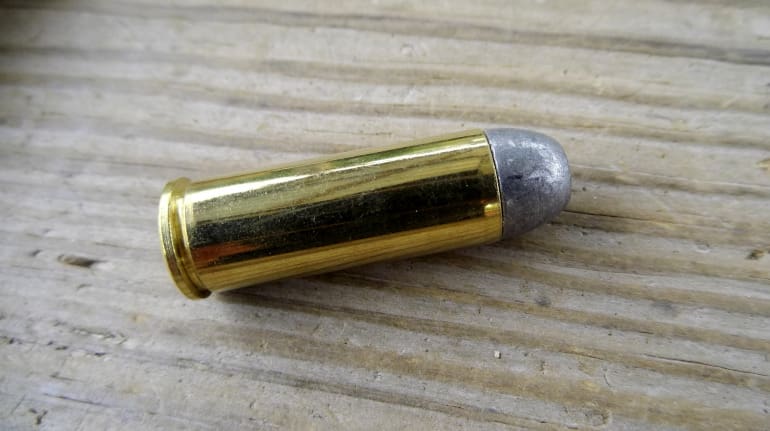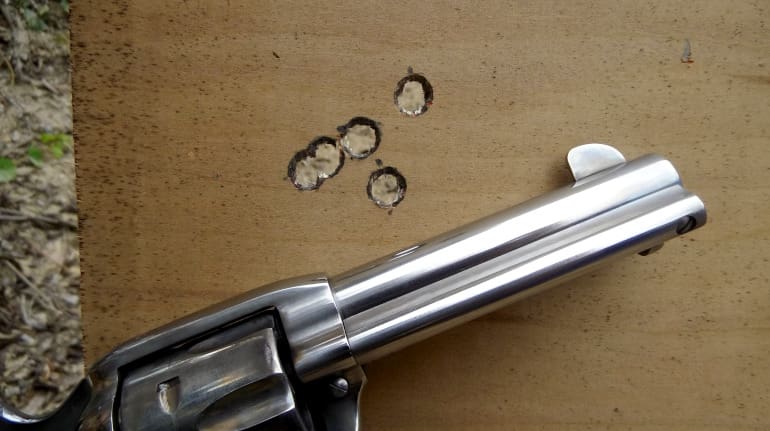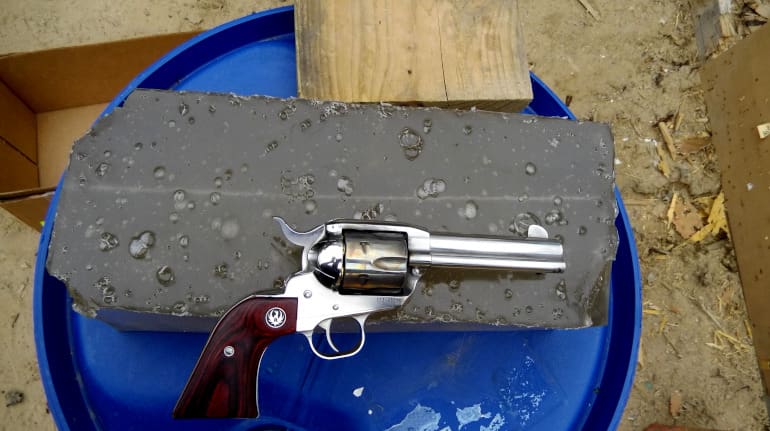
Black Hills Ammunition is known for producing some of the best cowboy action shooting ammo made today. I’m no gunslinger by any standard, but the quality, accuracy, and cool factor of the Black Hills Ammunition.45 Colt 250gr RNFP certainly makes me want to relive some of my favorite moments from the movies that I, and many of you, grew up on.
General Background
The .45 Colt, frequently also known as .45 Long Colt, is a cartridge with an interesting history. It was developed in the early 1870’s and achieved official adoption in 1873. It was originally chambered in the Colt Single Action Army revolver, also known as the Peacemaker.
It went on to cement its place in the American story when it was used in conflicts all over the frontier. Custer’s men fired it at Little Bighorn to no avail, but it wasn’t long before it was put to use avenging him and the 7th Cavalry.
So ingrained is the .45 Colt in our culture that it’s the cartridge of choice for every western hero ranging from Russell Crowe in 3:10 to Yuma, to John Wayne in everything he was ever in to Keith Carradine in Kill Bill. For the uncultured, Kill Bill is, in fact, a western.
The urge to relive and participate in that great American story of revenge, retribution, and gunplay is present in today’s cowboy action shooting sports and a great number of people use Black Hills cowboy action ammunition to fill the role of sheriff, outlaw or gambler.

The Black Hills load features a brass case and a large, solid lead round nose flat point bullet style with a hefty bullet weight of 250 grains. This is very similar to the original black powder loads used at the time, although these are smokeless and non-corrosive.
A box of fifty has a street price of about $35-40 depending on where you get it.
Accuracy and Basic Performance
I tested this load in the Ruger New Vaquero revolver. This particular revolver is made of stainless steel and is very solid and reliable. At 4.62″, it has a barrel shorter than the cavalry model made by Colt. This is, to the best of my knowledge, a favored size for cowboy competition.
Because this is a cowboy style load that may see some end use in competition, Black Hills loads it just a bit lighter than what was used at the time. The original loads had a 230gr bullet at about 1,000fps and 255gr loads at about 800-850fps, all of course dependent on barrel length and powder type.
This load generated an average muzzle velocity of 774fps at five feet from my Oehler 35P chronograph, which is plenty close to what was used back when.

Groups were excellent in the Ruger, with 25-yard accuracy coming in at an average of 3¼” for five-shot groups. I fired this load at ranges out to 100 yards on steel plates and found that it dropped them right in. The recoil was low and the shooting experience was extremely satisfying.
Ballistic Performance
I received a 10% FBI gel block from Clear Ballistics for this section of my testing. Now, you’re probably wondering why I’m testing this ammo like I do modern carry ammo and the answer is quite simple: lots of people carry .45 Colt today.
What? Really? Yeah, they do. Revolvers chambered for .410 like the Taurus Judge and Smith & Wesson Governor also chamber .45 Colt and it’s no stretch of the imagination that these big lead boys could be rattling around in someone’s belt as you read this. And they’re on more than a few nightstands.
The ballistic performance wasn’t at all shocking if you know much about hard lead bullets. They go straight through. When I say straight through, I mean they go straight through. The hard part is actually stopping them.
As you can see, the .45 Colt is easily capable of passing clean through a standard gel block. There was no expansion and no yaw. It just blew straight through. I put a few more in and they all did the same thing. They easily went right through fabric, denim, and leather and then clean through the gel.

Wounding Capacity
This load has historically been known to be a man-stopper. I can plainly see why because it just plows right through anything, even though it’s going slower than most people think bullets go today. I hear a lot that modern JHP loads are super-efficient, effective, and technologically advanced. Hell, I write all the time about advanced bullets. The thing is, plain old lead hasn’t gotten less effective with time and I don’t expect it to.
The wounds generated by this brick of a bullet aren’t particularly impressive to look at when comparing them side-to-side with something designed to rapidly and violently expand in soft tissue. But damn, if that simple, wide wound channel doesn’t scare the crap out of you, then you had better start taking guns more seriously.
Penetration was obviously deep. The issue here is over-penetration. The permanent wound channel measured about .5” all the way through. The flat nose is excellent for crushing and moving tissue.
Overall Impressions
Is this advanced, state-of-the-art carry ammo? Not really, but then again, it isn’t supposed to be. This is what it’s always been and modern shooters could learn a thing or two about what makes bullets work.
Black Hills has some cool stuff here and I love it for how simple and unassuming it is.
Ratings (out of five stars):
Accuracy: * * * * *
While not a jacketed match bullet, this load produces excellent accuracy at all ranges it was tested at.
Handling: * * * * *
Recoil was light and everyone who fired this load in the big Ruger New Vaquero commented on how pleasant it was. Expect some more recoil in a Judge or Governor that weighs a good 10 ounces less.
Reliability: * * * * *
I put 500 rounds of this load downrange and it went bang every time.
Terminal Performance: * * * *
Whether you call it .45 Colt or .45 Long Colt, it’s a big, wide bullet with sufficient muzzle energy to crush its way through at a relatively slow muzzle velocity. Instead of being hit by a golf ball out on the green, this is like being hit by a brick thrown from an overpass.
Overall: * * * * 1/2
I spend a great deal of time with a lot of very good ammo. I get to see the most modern and secret-squirrel stuff out there as any well-connected freelance journalist/day-drinker, but I love plain old lead so much more than anything coming off a CNC machine today. Be aware of the over-penetration issue and keep Rule No. 4 in mind. This type of ammo is just about as close to a romance novel as a man can get in his life. All we really want is a ranch to protect and a town full of hooligans to retreat to after work and this ammo puts you right back there.




I’ve shot the Leadville variety from Freedom Munitions, and found it to be 100 fps slower than the Black Hills and very soft shooting. Freedom makes a copper plated bullet that shoots very well and is quite accurate–within the range of my abilities–running around 750 fps. Shot out of my 4 3/4 inch Colt clone (Pietta) it is accurate and powerful. I have reloaded a bunch of brass with 35 gr of black powder, but because of the fires around here, the free outdoor ranges have all been shut.
As I understand it, the .455 Colt was designed with a cartridge capacity of 40 grains of black powder under a 250 grain RN for the original 7 1/2 1873, but at the Army’s request, it was downloaded to 35 gr. Cowboy shooters who prefer black powder usually report that 28-30 gr gives the best accuracy. (Because this is black powder, the excess space in the case must be filled with corn meal or a cork plug.)
The great thing abut lead is penetration. These bullets were supposed to be able to knock down Indian ponies out past 50 yards.
My issue with Leadville branded ammo is with how dirty it is. The amount of fouling I have to clean after metallic silhouette matches is far worse than other .45 Colt ammo I’ve shot. It seems like no matter how well I clean my Henry after a match there is always a significant amount of residue that seems to linger on for weeks. I haven’t shot the Black Hills but have used Ultramax – that wasn’t too bad. I have some 250 grain Fiocchi cowboy action rounds to try at the next shoot, we’ll see how they do.
The American Eagle JSP is probably one of my favorite branded loads to shoot in my Henry carbine.
We moderns tend to overlook the fact that the olden, golden days were more animal centric than modern times. Horses, mules and steers were a daily fact of life for the frontier types. Even without indians on the warpath more than one frontiersman has had to save his own life or the life of another when incidents involving these large animals happened. Being dragged by an out of control mount was a very real and present threat.
I remember seeing a drawing in my youth of a cowboy, in a corral. His horse is down and his leg is trapped under it. Across his fallen horse he’s nearly nose to nose with a large bull. And he has what looked like a break top Smith and Wesson in hand pointed right between that bulls eyes.
Roosevelt, Teddy, not the crippy one, tells of his western adventures. He related a wrangler shooting a bear that was attacking stock. The wrangler had a Colt SAA and the bullet went completely thru the bear at the shoulder. In one side and out the other. 1 shot, 1 kill.
“For the uncultured, Kill Bill is, in fact, a western.”
And so was (is) ‘Star Wars’…
But Han doesn’t shoot 45 Colt…there was a reason that the other films were listed and Star Wars wasn’t.
Han shot first. After ordering Greedo to Freeze and then telling him to Put His Hands Up.
Fukking rebel scum.
Han May have shot first but not with a Colt SAA 🤣
It was a long time ago, in a galaxy far, far away. Han had the finest German engineered pistol available.
Actually, with all the Sterlings and Lewis guns and mg42’s I would not be surprised to see the odd peacemaker thrown into the mix.
Lead bullets tend to generate lead smoke which is dangerous. Use these bullets outdoors and try to be upwind.
Boosht. Whichever way they’re pointed, try to be the other way, ‘cuz that’s the way the wind blows, yknow? Here in Tombstone, lead smoke is the least of your worries.
I think ranges and shooters over worry about “lead smoke”. If there’s enough ventilation it all should be ok, indoors or outdoors. The closest range to me used to allow unjacketed pistol calibers until recently, now it’s just .22 allowed unjacketed. The next closest range historically only allowed jacketed and had the additional requirement of all rifle calibers has to be purchased onsite.
Would like to see some of your reviews and thoughts on 45 Colt self defense rounds.
I’ve carried 44-40 & .45 as a personal defense round, for years. I found that my cousins .40 Glock usually caught a mesquite or cedar tree…instead of the coyote or pig. Not to mention the looks of uncertainty my shooter got when discovered by folks who should’ve crossed at the port of entry. It is not a round to take lightly, and in all of these years, neither have ever failed me.
Comments are closed.